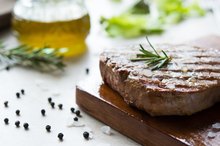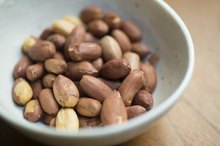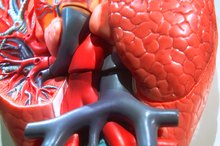The No Red Meat Diet
As its name suggests, the no red meat diet excludes all types of red meat, including pork, beef and lamb, though it isn't an officially-named diet. These meats have a reddish color because they contain higher amounts of a protein called myoglobin than white meats, according to the USDA. Abstaining from red meats may have several positive effects on your health.
Protein Sources
Because a no red meat diet excludes lamb, pork and beef, it focuses on other foods as protein sources. Other meats, such as white-meat chicken and turkey, fish and wild game meats may serve as alternate sources of protein. Plant-based foods may also provide protein in the no red meat diet. These foods include seeds, nuts, legumes, soymilk and meat replacements such as seitan, tempeh, textured vegetable protein and tofu.
- Because a no red meat diet excludes lamb, pork and beef, it focuses on other foods as protein sources.
Reduced Heart Disease Risk
The "Don't Eat Anything White" Diet
Learn More
Red meats are higher in saturated fats than white meats and plant-based proteins, according to Phyllis Balch, C.N.C., author of "Prescription for Nutritional Healing." Saturated fats may elevate triglycerides and low-density lipoproteins -- the bad components of cholesterol. Elevated levels of low-density lipoproteins and triglycerides contribute to lipid blockages in your arteries, which restrict blood flow and increase your risk of heart disease. A no red meat diet may help prevent arterial blockages that lead to stroke, heart attack and coronary artery disease.
- Red meats are higher in saturated fats than white meats and plant-based proteins, according to Phyllis Balch, C.N.C., author of "Prescription for Nutritional Healing."
- Elevated levels of low-density lipoproteins and triglycerides contribute to lipid blockages in your arteries, which restrict blood flow and increase your risk of heart disease.
Reduced Cancer Risk
Eliminating red meats from your diet may lower your risk of cancer, according to the American Institute for Cancer Research. Frequent consumption of red meats is linked to the development of several types of cancer, including cancer of the colon, rectum, stomach, prostate, bladder and lungs.
Considerations
Red Meat & Its Effect on the Liver
Learn More
Although red meats are among the most well-known sources of protein in the United States, a no red meat diet does not pose a risk of protein deficiency. White-meat and plant-based foods can easily provide sufficient protein to maintain energy levels and facilitate cellular repair. Although red meat is a rich source of iron, which is necessary for the production of red blood cells and hemoglobin, dietary iron can be consumed from poultry, fish, legumes, kale and spinach if you opt to eliminate red meat from your diet.
Related Articles
References
- American Institute for Cancer Research: Food, Nutrition, Physical Activity, and the Prevention of Cancer: a Global Perspective
- "Prescription for Nutritional Healing"; Phyllis A. Balch, C.N.C.; 2010
- Cleveland Clinic. Cholesterol & nutrition: TLC.
- Health.gov. Dietary guidelines 2015-2020.
- American Heart Association. Fish and omega-3 fatty acids. Reviewed March 23, 2017
- American Heart Association. Meat, poultry, and fish: picking healthy proteins. Reviewed March 26, 2017
- American Heart Association. Top ten tips for healthy grilling and barbecuing. Reviewed February 9, 2017
- National Cholesterol Education Program. Third Report of the Expert Panel on Detection, Evaluation, and Treatment of High Blood Cholesterol in Adults. 2002.
- Rolfes SR, Whitney E. Understanding Nutrition. 14th ed. Independence, KY: Wadsworth Publishing; 2015.
- The American Heart Association. Meat, Poultry, and Fish: Picking Healthy Proteins. 2016.
- U.S. Food and Drug Administration. Guidance for Industry: A Food Labeling Guide. 2013.
Writer Bio
Owen Pearson is a freelance writer who began writing professionally in 2001, focusing on nutritional and health topics. After selling abstract art online for five years, Pearson published a nonfiction book detailing the process of building a successful online art business. Pearson obtained a bachelor's degree in art from the University of Rio Grande in 1997.









